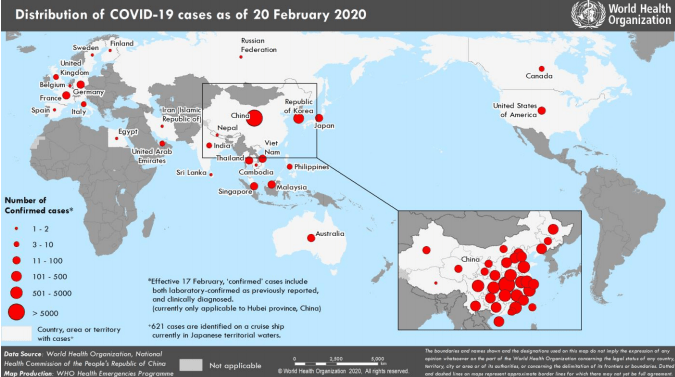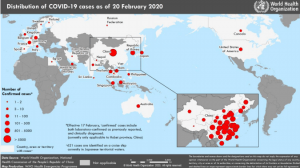
EMS and Coronavirus. How emergency systems should respond to COVID-19
Coronavirus, also called COVID-19 is now the main worry of the entire world. Each country took its own precautions to limit the infection. Dr Saad AlQahtani explains how EMS systems are responding to Coronavirus.
The entire world is speaking about Coronavirus, or COVID-19 which is spreading out of China since the beginning of 2020. Its transmission is fast and, according to WHO 2020, a total of 75,748 COVID-19 confirmed cases and 2,129 death was reported globally.
Dr Saad AlQahtani, Clinical Researcher, National Ambulance in Abu Dhabi (UAE) participated at Arab Health 2020 at the end of January, where he had to speak about CBRNE and biological incidents. Since the coronavirus started to spread throughout the various countries of the world, he retained that speaking also of COVID-19 was useful and appropriate in those circumstances. The importance is to remain quiet and reassure patients without spreading panic.
After that, he had received a lot of questions and discussions regarding the EMS role in this type of outbreaks, like the coronavirus one. Due to the fast-spreading of this virus globally, it becomes essential to share with other EMS organizations a summary of how to act in case of a suspect patient.
BELOW THE OFFICIAL ISSUE:
“In December 2019, the new virus started in the Wuhan, China and by early 2020 the virus spread to other countries in fast transmission with an increase in the number of morbidity and mortality. Officially this virus has been announced by WHO as an international health emergency and been named as (COVID-19). Up to date, there is no actual treatment to cure this virus.
During the Arab Health conference 2020 in Dubai, we explained the importance of developing EMS systems globally when responding to biological incidents such as (COVID-19). As EMS is the first gate of healthcare and plays a very important role in public health and should be working with national and international authorities to ensure proper control of infectious diseases from the transmission.

According to WHO 2020 about 26 countries had impacted, a total of 75,748 COVID-19 confirmed cases and 2,129 death was reported globally. The risk of this virus is high according to WHO and require immediate actions. As controlling this outbreak became an international concern, it is essential to ensure the safety of the EMS personal when responding to suspect COVID-19 patients.
There are a lot of challenges facing EMS personnel when responding to COVID-19 cases, but it is very
important to develop new identification tool and methods starting from the Emergency Dispatch Center
(EMD) or Ambulance Call Center (ACC) when responding to daily emergency calls during the outbreak
season.
The flow chart below shows the roles of the ambulance call taker in identifying the signs and symptoms of suspected COVID-19 patient, by modifying caller queries prior dispatching the ambulance. If the patient is COVID-19 suspected either by the caller or ambulance dispatcher, EMS personal should wear full PPE prior entering the scene including the ambulance driver. All staff must be aware of their suitable sizes.
Clinicians must avoid touching their skin or eyes at all. It is very important to prevent relative, bystanders and other emergency services such as police or firefighter from direct contact with the patient. Placing surgical mask on all suspect patients is very important and provide the pre-hospital treatment according to the clinical guideline with full cation. If the EMS personal attending to non-identified or no suspect COVID-19 patients, clinicians must ensure that they wear PPE according to the infection control guideline, and always try to initiate patient assessment from a distance if possible.
If any sign or symptoms of infection is presented clinicians must wear full PPE and inform dispatch center to notify receiving hospital. During the transportation to the receiving hospital, EMS dispatcher must coordinate with receiving hospital about location, preparation for receiving the patient, isolation etc. Post patient handover EMS
staff must remove and discard all PPE and disposables according to the routine procedure.
Hand hygiene and removal of uniform if get exposed to fluid or blood. EMS staff must ensure the full any ambulance compartment, assets, equipment used for suspected COVID-19 patient must not return to the service until full deep cleaning performed. Coordination between EMS, hospital and local authorities very important to ensure the safety of all staff. If the EMS personal transported suspected COVID-19 patient to the hospital, it is very important to update the ambulance services about the patient status either positive or negative, to ensure EMS personal to be screened.
Finally, it is also recommended that when EMS personnel attending to large events or MCI during the
outbreak season to wear PPE, and to avoid any direct contact with patients to prevent the transmission
of the disease.”
EMS responding to COVID-19 PDF
REFERENCES:
- Centers for Disease Control and Prevention. (2020). Coronavirus Disease 2019 (COVID-19). [Accessed 18Feb. 2020]. Interim Guidance for Emergency Medical Services (EMS) Systems and 911 Public Safety Answering Points (PSAPs) for COVID-19 in the United States
- Centers for Disease Control and Prevention. (2020). Coronavirus Disease 2019 (COVID-19). [online] Flowchart to Identify and Assess 2019 Novel Coronavirus [Accessed 12 Feb. 2020].
- Centers for Disease Control and Prevention. (2020). Coronavirus Disease 2019 (COVID-19). [online] Evaluating and Reporting Persons Under Investigation (PUI) [Accessed 19 Feb. 2020].
- Who. (2020). Coronavirus disease 2019 (COVID-19) Situation Report – 31. [online] Coronavirus disease 2019 (COVID-19) Situation Report – 31 pdf [Accessed 23 Feb. 2020].
- Who. (2020). Global research on coronavirus disease (COVID-19). Global research on coronavirus disease (COVID-19) [Accessed 20 Feb. 2020].


